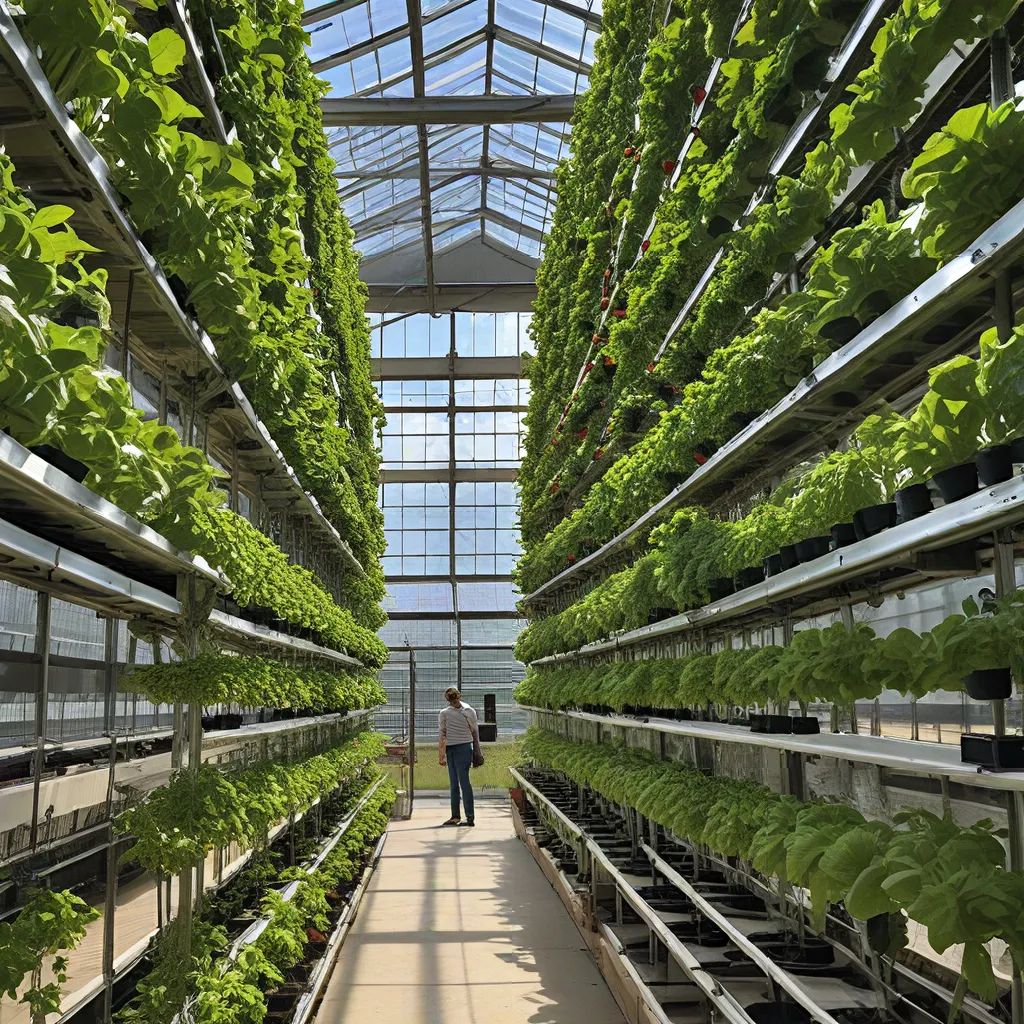
The Looming Challenge of Feeding the World
Picture this: mile after mile of lush, verdant farmland, with rows of crops stretching as far as the eye can see. It’s the quintessential image of agriculture, one that has sustained humanity for millennia. But as we stand at the cusp of a new era, this traditional landscape is facing a daunting challenge.
By 2050, the global population is projected to reach a staggering 9.8 billion people. That’s a whole lot of mouths to feed. And if we continue with our current agricultural practices, we’ll need to increase food production by a staggering 70% just to keep up. Yikes!
The problem is, our conventional farming methods are, well, conventional. They’re maxed out, both genetically and chemically. Slathering on more fertilizers and pesticides isn’t going to cut it. And expanding our farmland? That’s a non-starter – we’ve already pushed the limits of what our planet can handle.
So, what’s the solution? Cue the solar-powered vertical farm. This innovative approach to agriculture just might be the key to feeding the world’s rapidly growing population, all while protecting our precious environment.
A Vertical Revolution in Farming
Imagine a farm, but instead of stretching out horizontally, it grows upwards – stacking layer upon layer of verdant crops in a controlled, indoor setting. These vertical farms are a marvel of modern technology, harnessing the power of the sun, water, and nutrients to produce an astounding amount of food in a fraction of the space.
At the heart of this revolution is AeroFarms, a pioneering company that’s leading the charge towards a more sustainable future. With their innovative aeroponics system, AeroFarms is able to grow crops without soil, using just a mist of nutrient-rich water to nourish the plants. And get this – they can do it all year round, regardless of weather conditions, in a space that’s up to 99% smaller than a traditional farm.
“It’s not where the mouths are, but where the produce distribution centers are,” explains AeroFarms CEO David Rosenberg. “We’ve gone from a lens of hyper-local to a more looser definition of local.”
By strategically locating their vertical farms near urban centers, AeroFarms is able to drastically reduce the carbon footprint associated with transporting produce. No more shipping leafy greens and berries halfway across the country – these crops are grown right in the heart of the community, ensuring freshness and sustainability.
Unlocking the Power of the Sun
But AeroFarms isn’t just revolutionizing the way we grow our food; they’re also harnessing the power of the sun to power their operations. That’s right, these high-tech farms are solar-powered, using photovoltaic cells to generate clean, renewable energy.
“Energy stands out as one of the bigger hurdles facing the vertical farming industry,” acknowledges Julia Kurnik, director of innovation startups at the World Wildlife Fund. “Because it already is making great gains around things like water use, pesticide use, food loss and food waste.”
AeroFarms is tackling this challenge head-on, carefully selecting locations with access to renewable energy sources like hydropower. And they’re not just relying on solar panels – they’re also working with partners like Nokia Bell Labs to incorporate cutting-edge technologies like advanced networking, autonomous systems, and machine learning to further optimize their energy efficiency.
“Lets be more efficient,” says AeroFarms CTO Roger Buelow. “Lets make sure we are getting the most pounds per square meter per photon we can get. So that were really being good stewards with that energy And were making sure that every photon gets to do its job.”
Cultivating a Sustainable Future
But the benefits of AeroFarms’ solar-powered vertical farms extend far beyond just energy efficiency. These high-tech farms are also revolutionizing the way we approach agriculture, tackling a whole host of pressing environmental and social issues.
For starters, water conservation is a major priority. Traditional farming is the single largest consumer of freshwater, accounting for around 70% of total withdrawals. AeroFarms, on the other hand, uses up to 95% less water than conventional agriculture, thanks to their innovative aeroponics system.
And then there’s the issue of soil degradation. Intensive farming practices have taken a toll on the Earth’s vital natural resource, eroding the very foundation of our food supply. But with vertical farming, there’s no need for soil at all – the plants thrive in a nutrient-rich, soil-free environment.
“Sustainable farming adopts techniques like minimal tillage, cover cropping, and crop rotation to preserve soil health, thus ensuring the long-term productivity of agricultural lands,” explains the Landgate report. “Vertical farming eliminates the need for these practices, as it operates in a completely controlled environment.”
But the benefits of AeroFarms’ solar-powered vertical farms don’t stop there. These high-tech farms are also tackling the issue of food deserts, bringing fresh, nutritious produce to underserved communities. And they’re providing job opportunities for the local workforce, including programs for formerly incarcerated individuals.
“We want to go into those communities and inspire those communities,” says Rosenberg. “By entering an economically depressed city, AeroFarms can address food deserts and help alleviate them by providing locally sourced food and creating jobs.”
The Future is Bright (and Vertical)
As the world grapples with the challenges of climate change, population growth, and resource scarcity, the solar-powered vertical farm is poised to become a game-changer in the world of sustainable agriculture. By harnessing the power of the sun, conserving precious resources, and bringing fresh, local produce to communities in need, these high-tech farms are cultivating a future that’s not just bountiful, but also clean, green, and equitable.
So, the next time you’re browsing the aisles of your local energy-saving products website, keep an eye out for the fresh, delicious produce from AeroFarms. It’s not just good for your taste buds – it’s good for the planet, too.